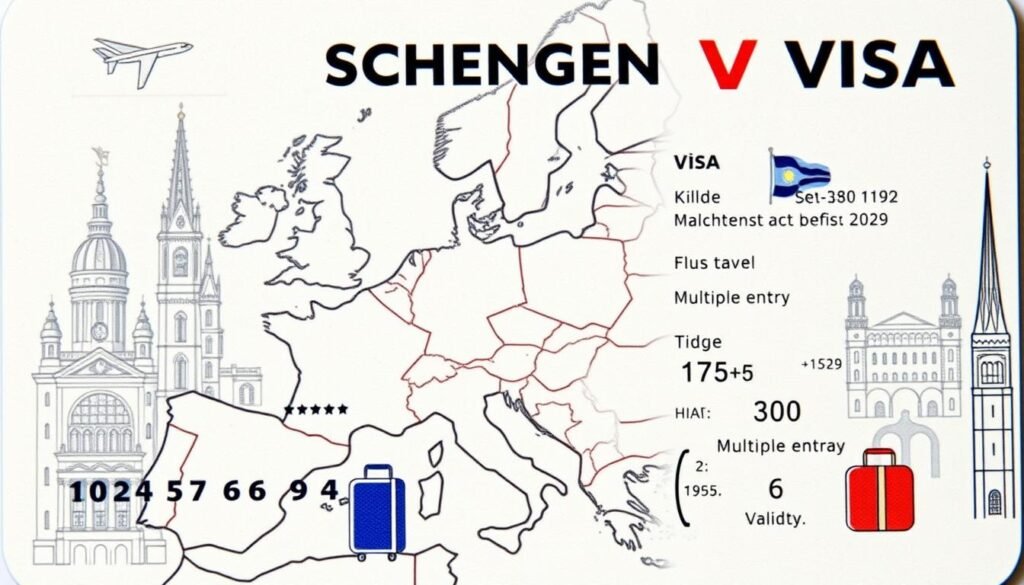Can I Use My Schengen Visa to Travel Multiple Countries in 2025?
Table of Contents
Imagine standing at France’s border, your heart full of excitement. You hold your passport, wondering if your Schengen visa will let you explore many European countries. The dream of easy travel across beautiful landscapes and cultures is real.

Having a Schengen visa means endless possibilities. It lets you visit 29 countries without needing many visas. The Schengen visa rules are simple: one visa, many countries, and countless adventures.
Your Schengen visa is more than a travel pass. It’s a key to experiencing Europe, letting you easily move between places like France, Italy, and Germany. Knowing how to use your Schengen visa for traveling across Europe will make your trip unforgettable.
Key Takeaways
- Schengen visa covers 29 European member states
- Travelers can move freely between participating countries
- Visa typically allows 90-day stays within a 180-day period
- Some non-Schengen countries accept Schengen visa for entry
- Careful planning is crucial for multi-country travel
Understanding the Schengen Visa Basics
Traveling through Europe is now more exciting with the Schengen Visa. This travel document lets you explore many European countries easily.
A Schengen Visa is your ticket to easy European travel. It lets you visit 26 countries with just one document. This visa makes traveling simpler by cutting down on border checks.
What is a Schengen Visa?
The Schengen Visa is a short-stay permit for up to 90 days in 180 days. It’s your ticket to Europe’s rich culture without the need for many visas.
Types of Schengen Visas Available
- Single-entry visa: Allows one entry into the Schengen Area
- Double-entry visa: Permits two entries within the visa validity period
- Multiple-entry visa: Enables multiple entries over two years
Visa Categories and Their Benefits
The Schengen visa application process has different categories for various travel needs:
- Tourist Visa: Great for those exploring Europe for fun
- Business Visa: For professionals attending meetings or conferences
- Transit Visa: For travelers just passing through Schengen countries
“The Schengen Visa is your gateway to experiencing the diverse cultures of Europe with unprecedented ease and flexibility.”
Knowing the Schengen visa requirements is key. The visa fee is about €80 (around $90), with discounts for kids. It usually takes 15 days to process, so apply early, at least 90 days before your trip.
For a successful application, prepare well, have all the right documents, and plan ahead.
Can I Use Schengen Visa to Travel Multiple Countries
Are you thinking about traveling across European borders? A Schengen visa lets you explore many countries. In 2023, about 4.6 million visas were given for multiple entries, making up 54.2% of all visas.
The Schengen visa area countries open up amazing travel chances. With this visa, you can easily move between 26 European countries without facing extra border checks. You can see France, Germany, Italy, Spain, and more with just one travel document.
“A Schengen visa is like a golden ticket to European exploration” – Travel Expert
Your travel options depend on the Schengen visa type you get:
- Single Entry Visa: One-time entry into Schengen zone
- Double Entry Visa: Two entries within a set period
- Multiple Entry Visa: Unlimited entries during visa validity
Knowing your visa type is key when planning to travel with a Schengen visa. Multiple entry visas give you the most freedom, letting you cross borders easily in the Schengen area.
Remember, even though the visa lets you move between countries, you must follow the total allowed stay. This is usually 90 days in 180 days.
Schengen Area Member States and Their Requirements
Exploring the Schengen Area can be tricky. Knowing the rules of each country helps you plan a great trip. Over 425 million people enjoy easy travel here.
Comprehensive List of Participating Countries
Right now, 29 European countries are part of the Schengen Area. They’ve agreed to let people move freely between them. This makes traveling easier across the area.
- European Union Members: Austria, Belgium, Croatia, Czechia, Denmark, Estonia, Finland, France, Germany, Greece, Hungary, Italy, Latvia, Lithuania, Luxembourg, Malta, Netherlands, Poland, Portugal, Slovakia, Slovenia, Spain, Sweden
- Non-EU Schengen Countries: Iceland, Norway, Switzerland, Liechtenstein
- Recent Additions: Bulgaria and Romania (effective March 31, 2024)
Border Control Regulations
Even though borders are open, there are rules. Countries can close borders if there’s a big security risk.
Country-Specific Entry Rules
Every country in the Schengen Area has its own rules for visitors. Important things to remember include:
- Valid passport with at least 3 months remaining
- Proof of enough money
- Travel insurance that covers €30,000 for medical emergencies
- Confirmed return or onward travel tickets
“Free movement doesn’t mean unrestricted access – each country maintains its own specific entry criteria.”
Before you start your European trip, check the rules for each country. This way, you’ll have a smooth journey through the Schengen visa area countries.
Duration and Validity of Schengen Visa

Understanding the schengen visa validity is key for planning your European trip. Your Schengen visa has rules that tell you how long you can stay. This lets you explore the Schengen Area’s beauty.
The standard short-term Schengen visa (Type C) lets you stay up to 90 days within a 180-day period. You can visit many Schengen countries in this time. But, your total stay can’t go over 90 days.
“Know your visa rules before you travel to avoid unexpected complications at the border.”
Different Schengen visas offer different travel options:
- Single-entry visa: One-time entry into Schengen countries
- Double-entry visa: Allows two entries during visa validity
- Multiple-entry visa: Permits numerous entries within the visa’s valid period
The rules for Schengen visas are strict about overstaying. If you stay more than 90 days, you face serious legal issues. This could include travel bans in the future.
Visa validity periods vary. Some visas are valid for weeks, while others last up to a year. Always check your visa sticker for exact entry and stay details.
Pro tip: Use the 90/180 rule to plan your stay. This ensures you follow Schengen visa rules.
Planning Your Multi-Country European Journey
Traveling with a Schengen visa lets you explore many European countries. You need to plan well and know the Schengen visa rules. This will make your trip smooth and unforgettable.
Creating an Effective Travel Itinerary
Planning your European trip involves a few key steps:
- Research the Schengen countries you want to visit
- Understand the 90-day stay limit within a 180-day period
- Plan your route to maximize travel experiences
- Check specific entry requirements for each country
Documentation Requirements
Traveling with a Schengen visa needs good documentation. You’ll need:
- Valid passport (must be valid for at least three months beyond your planned stay)
- Completed Schengen visa application
- Travel insurance covering at least €30,000 in medical expenses
- Proof of accommodation for each destination
- Round-trip flight itinerary
“Preparation is the key to a stress-free European journey.” – Travel Expert
Border Crossing Procedures
When crossing borders, follow the Schengen visa rules closely. Be ready for passport checks and questions about your trip. Remember, border control can change without warning, so always carry your passport and visa.
Pro tip: Keep digital and physical copies of all important travel documents. This helps with smooth border crossings across different Schengen countries.
Entry/Exit System (EES) and ETIAS Requirements

The European Union is changing travel rules with two new systems: the Entry/Exit System (EES) and the European Travel Information and Authorization System (ETIAS). These systems will change how people from outside the EU travel in Europe.
Starting November 10th, 2024, the Entry/Exit System will change how we cross borders. It will use technology instead of stamps in passports. It will collect important information about travelers automatically.
- 29 European countries will participate in the EES
- Travelers must scan passports at self-service kiosks
- Biometric data including facial images and fingerprints will be collected
- Maximum stay remains 90 days within a 180-day period
Now, travelers must register digitally. They need to give detailed information, such as:
- Full name and date of birth
- Travel document validity
- Entry and exit data
- Biometric identifiers
Preparation is key. The ETIAS system will start in Q2 2025. It will need travelers to get online permission before they go. The process is easy and costs €7, and it’s good for three years.
“These systems represent a significant digital transformation in European border management and security.” – EU Immigration Policy Expert
Travelers should know the rules to avoid trouble. Breaking the rules can lead to being banned, fined, or deported. Knowing these rules will make traveling in Europe easier.
Common Mistakes to Avoid When Traveling in Multiple Schengen Countries
Traveling with a Schengen visa needs careful planning. Many travelers face challenges that can make their trip harder. Knowing the common mistakes can help you avoid them and have a better trip.
Overstaying Your Visa Period
The biggest mistake is staying longer than allowed. The Schengen visa rules have a 90/180 rule. This means you can stay up to 90 days in 180 days. Staying longer can lead to:
- Immediate deportation
- Hefty fines
- Future travel restrictions
- Potential ban from entering Schengen countries
Improper Travel Documentation
Incorrect or missing documents can ruin your trip. In 2023, over 1.6 million visa applications were denied. Most of these were because of document issues.
| Documentation Requirement | Specific Details |
|---|---|
| Passport Validity | Must be valid for 6 months beyond travel date |
| Travel Insurance | Minimum €30,000 coverage |
| Proof of Funds | Varies by country (e.g., €100 for Austria) |
Border Crossing Errors
Going through border crossings needs careful planning. You should know:
- Submit your visa application to the first country you enter
- Carry all needed documents
- Know the entry rules of each country
- Keep track of your days in the Schengen Area
Pro tip: Always keep a detailed travel log and maintain copies of all important documents to avoid potential complications.
Knowing these common mistakes can make your European trip better and less stressful.
Conclusion
Learning how to use a Schengen visa for traveling in Europe can change your trip. The Schengen Area lets you visit 26 countries with one visa. This makes exploring different cultures and landscapes easy without dealing with many borders.
To travel well across countries, plan carefully and prepare fully. When you apply for your Schengen visa, collect all needed documents. Apply at the embassy of your main destination and show you have a clear plan. The visa offers great freedom to plan your perfect European trip.
Use digital tools like Skyscanner, Rome2Rio, and Google Maps to organize your trip. Budget airlines like Ryanair and EasyJet make traveling between countries cheap. Europe’s rail network is also a great way to get around. With the right knowledge and planning, your European adventure will be unforgettable.
Keep up with new rules like the Entry/Exit System (EES) and ETIAS to travel smoothly. With good planning and knowing the Schengen visa rules, your European dream is closer than you think.
FAQ
Can I use a Schengen visa to travel to multiple countries?
Yes, a Schengen visa lets you travel freely in 26 European countries. You can move between them without checks during your visa’s time.
How many countries can I visit with a single Schengen visa?
You can visit all 26 Schengen Area countries. This includes places like France, Germany, Italy, and Spain. Just remember, you can’t stay more than 90 days in 180 days.
What types of Schengen visas are available?
There are three main Schengen visas: single-entry, double-entry, and multiple-entry. They’re for tourism, business, or transit. Each has different rules and times.
How long is a Schengen visa valid?
A Schengen visa is usually good for up to 90 days in 180 days. The exact time is on the visa sticker. It depends on your visa type and travel plans.
Do I need to apply for a visa for each country I visit?
No, one Schengen visa covers all Schengen Area countries. But, apply through the embassy of your first or longest stay country.
What documents do I need to apply for a Schengen visa?
You’ll need a valid passport, a visa application form, and photos. Also, travel insurance, accommodation proof, itinerary, and financial support proof.
Are there any upcoming changes to Schengen visa regulations?
Yes, the Entry/Exit System (EES) and ETIAS will start soon. Visa-exempt travelers must get an ETIAS online and pay a fee to enter the Schengen Area.
What are common mistakes to avoid with a Schengen visa?
Don’t overstay your visa to avoid fines and travel bans. Make sure your documents are complete. Know border rules and track your travel and visa dates.
Can I work or study with a Schengen visa?
No, a Schengen visa is for short visits, not work or study. You need specific visas for those activities.
What happens if I overstay my Schengen visa?
Overstaying can lead to fines, deportation, and travel bans. Always follow your visa’s rules and time limits.





